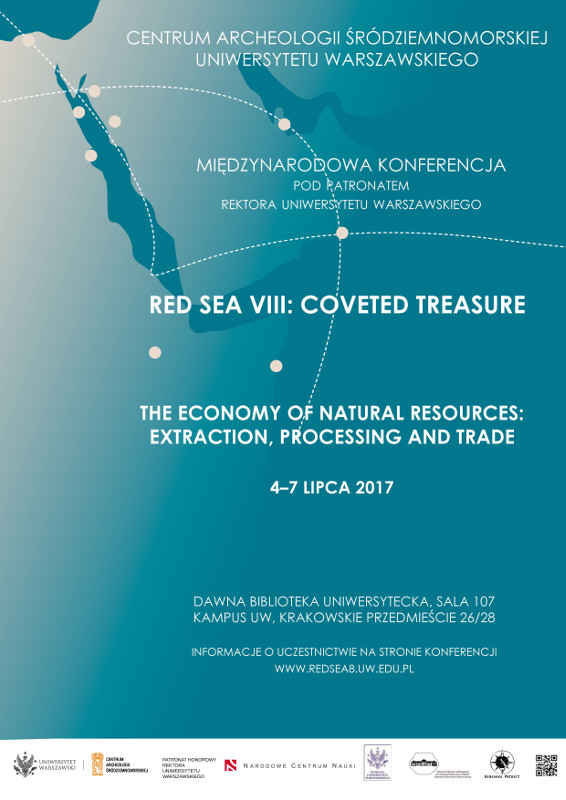During the 4-day long event, presentations will be grouped in thematic sessions related to the circulation of natural resources, Indian steel (including a live metalurgic experiment), jewlery from the western Indian Ocean basin and ancient trade in incense and frankincense. The opening lecture by Dr. Eivind Heldas Seland (Bergen University) will be an overview of research on the subject: Thirty years of Red Sea studies: insights, agendas, perspectives.
The Red Sea conferences have been held biannually at scientific institutions in the United Kingdom, Saudi Arabia and Italy involved in research on the region. This year’s edition has been organized by the Polish Centre of Mediterranean Archaeology, University of Warsaw (PCMA). The PCMA has been involved in research on the Egyptian coast of the Red Sea for over a decade, working with the University of Delaware at the port site of Berenike. In 2014 a PCMA team started work at Aynuna in Saudi Arabia, another harbor site, thus spanning the two sea shores.
The metallurgic panel will take a look at metalworking technologies from prehistoric times to the Islamic period. An experiment will be performed aimed at reconstructing the unknown process of melting hypereuctectoid steel, commonly known as Indian steel (produced between 300 BC and AD 600. Participants will observe the preparation of a melting crucible and the actual melting process.
Long disregarded and overlooked in research, personal adornments are an important aspect of material culture which can contribute significantly to studies of economic, social and even political issues. The aim of this panel is to provide an overview of ancient jewelry from various periods, beads in particular, circulating in the Red Sea and around the Arabian Peninsula to East Africa and India.
A panel on natural resources will work toward a network visualisation of how the different commodities – natural resources specifically moved according to different patterns. The results will then be compared to a similar network analysis of comparable commodities traded along the Red Sea, extracted as a list from the Periplus, the 1st century AD sailing and trading guide.
Incense was one of the most important luxury items of trade in antiquity. The incense trade flourished from the 8th century BC to approximately the 2nd century AD and linked the incense producing areas of Arabia and Africa with markets as far and wide as the Mediterranean, the Levant, Egypt, Mesopotamia, the Indus and China. This trade led to many wide scale cultural, social, political and economic changes.
The conference will be preceded by a separate workshop “Arabian Red Sea Route” (3 July 2017) which is organized by the team of the Aynuna Project in Saudi Arabia.
The Berenike and Aynuna projects received founding from the Polish National Science Centre (grants UMO-2015/17/N/HS3/00163 and UMO-2014/14/M/HS3/00795 respectively). The smelting experiment is hosted and co-organized by the State Archaeological Museum in Warsaw. The conference is organized under the patronage of the Rector of the University of Warsaw. It received funding i.a. from the University of Warsaw Foundation.
Go to www.redsea8.uw.edu.pl and www.pcma.uw.edu.pl/EN for more information on the events and on registration.
Red Sea VIII: Coveted treasure
> Tuesday–Friday, 4–7 July 2017 r.,
Old Library UW, hall 107
Krakowskie Przedmieście st 26/28
Opening lecture: Tuesday, 4 July, 10 a.m.
> Thursday, 6 July 2017 r. 9 a.m.–1 p.m.
State Archaeological Museum in Warsaw
Długa st 52
Smelting experiment
> Thursday, 6 July 2017 r. 1 p.m.
State Archaeological Museum in Warsaw
Długa st 52
Workshop The Arabian Red Sea Route
> Monday, 3 July 2017, 9 a.m.–6 p.m.
Institute of Archaeology, University of Warsaw, Hall 210
Krakowskie Przedmieście st 26/28
Red Sea VIII: program and abstracts

